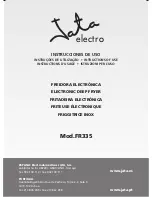
6-12
n
HybridCare™ Dryer with Heat Pump Technology
TESTING
For Service Technician Use Only
DANGER
Electrical Shock Hazard
Only authorized technicians should perform
diagnostic voltage measurements.
After performing voltage measurements,
disconnect power before servicing.
Failure to follow these instructions can result in
death or electrical shock.
TEST #4b: Heat Pump
IMPORTANT: At the time of writing this job aid, the Heat
Pump must be replaced as an assembly if any of the
sealed system components malfunction. This includes the
compressor, heat exchanger components (evaporator and
condenser), the post condenser, expansion valve, and all
tubing and fittings.
Heat Pump does not heat:
PROCESS AIR FLOW:
1. Similar to a vented dryer, restricted air flow will cause
drying performance issues in a ventless dryer. Check all
three filters (primary lint filter, secondary lint filter, and
the service filter) for restriction and clean as necessary.
2. If a lot of lint or debris is observed on the service filter,
remove the heat exchanger cover and vacuum the service
filter and any lint or debris from the fins and coils of the
evaporator and condenser.
COMPRESSOR:
Compressor runs but cycles due to overheating.
1. Check for restricted air flow caused by dirty filters or heat
exchanger. (See “Process Air Flow” above.)
2. Auxiliary Fan - used to cool the post condenser and
compressor electronics. Perform TEST #10: Auxiliary Fan/
Relay Expansion, page 6-21, to verify the operation of the
auxiliary (post condenser)fan.
Compressor does not start/humming noise:
1. Quick Check: Perform steps under “Install Diagnostics”,
page 5-4, to test for L1 and L2 line voltage.
¾
If L1 and L2 are present, go to step 2.
¾
If L1 and L2 are not present, go to TEST #2: Supply
Connections on page 6-6.
2. Unplug dryer or disconnect power.
3. Perform the procedure to remove the belt and drum on
page 4-10, to access the compressor/heat pump assembly.
4. Visually check the connections between the compressor
and run capacitor.
5. If the connections look good, check the capacitor for
leaks, corrosion, bulging of the metal canister, or any
other physical signs that the capacitor should be replaced.
6. Test the compressor run capacitor.
a. Discharge the capacitor by touching the leads of a
20,000 Ω resistor to the two terminals.
b. Disconnect the wires from the capacitor terminals.
c.
ANALOG METER
- Set your meter to ohms (resistance)
function, range to R x 10,000, or the highest scale on
the meter. Touch the meter leads to the capacitor
terminals. The meter should indicate nearly a short
circuit initially, then a steady increase in resistance
should be noted. The needle will move more slowly
as it creeps up. If your capacitor has a resistance of at
least 100K (100,000 ohms) it is good.
If the needle doesn’t move when you connect the
leads to the capacitor, the capacitor is open. If the
needle indicates a short initially and stays there, the
capacitor is shorted. Replace the capacitor.
DIGITAL METER
- If you have a digital multi-meter with
an autoranging function, set the meter to the ohms
(resistance) function. Pay attention to the resistance
units displayed on the meter readout. No units = ohms.
“K” = the readout value times 1,000 ohms. “M” = the
readout value times 1,000,000 ohms.
Proceed as described with the analog meter for the
test. What you’re looking for is a low initial resistance
which climbs steadily until it exceeds 100,000 ohms.
If the value is below 100,000 ohms (100K) but above
10,000 ohms (10K), the capacitor is weak and should
be replaced.
7. If the preceding steps did not correct the compressor
problem, proceed to next section: “Compressor does not
run.”
Compressor does not run:
1. Quick Check: Perform steps under “Install Diagnostics”,
page 5-5, to test for L1 and L2 line voltage.
¾
If L1 and L2 are present, go to step 2.
¾
If L1 and L2 are not present, go to TEST #2: Supply
Connections on page 6-6.
2. Unplug dryer or disconnect power.
3. Remove top panel to access the machine electronics.
4. Check Compressor Wiring—use an ohmmeter to
measure the resistance at the violet wire terminal on the
compressor relay (K2) and L2 at the terminal block.
¾
If the resistance is between 2 to 15 Ω, go to step 11.
¾
If an open circuit is detected, go to step 5.
5. Perform the procedure to remove the belt and drum, page
4-10, to access the compressor/heat pump assembly.
6. Visually check the connections between the compressor
relay and the compressor components, and the
compressor components and the L2 terminal.
Содержание WED99HEDC0
Страница 12: ...1 8 n HybridCare Dryer with Heat Pump Technology GENERAL INFORMATION Notes ...
Страница 26: ...2 14 n HybridCare Dryer with Heat Pump Technology OPERATION Notes ...
Страница 48: ...3 22 n HybridCare Dryer with Heat Pump Technology INSTALLATION Notes ...
Страница 68: ...4 20 n HybridCare Dryer with Heat Pump Technology COMPONENT ACCESS Notes ...
Страница 98: ...6 22 n HybridCare Dryer with Heat Pump Technology TESTING Notes ...
Страница 100: ...W10764068A HybridCare Duet Dryer with Heat Pump Technology ...













































